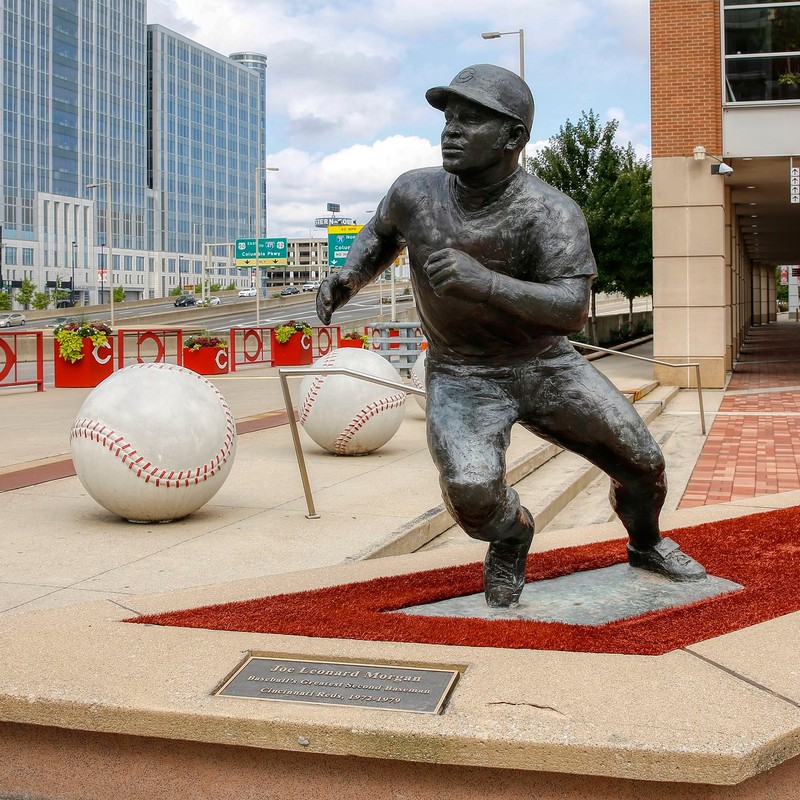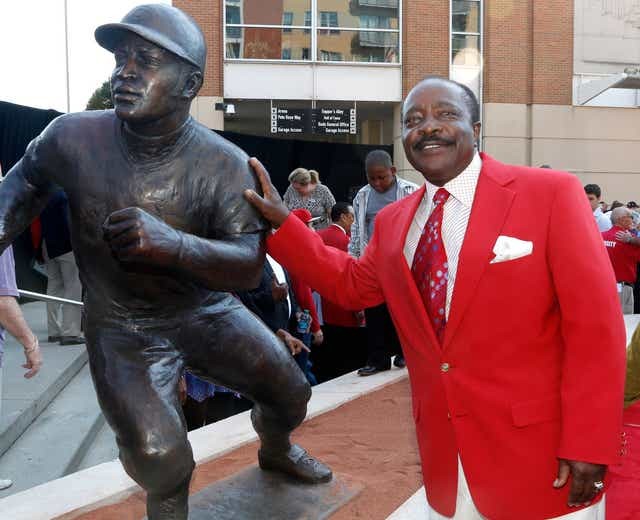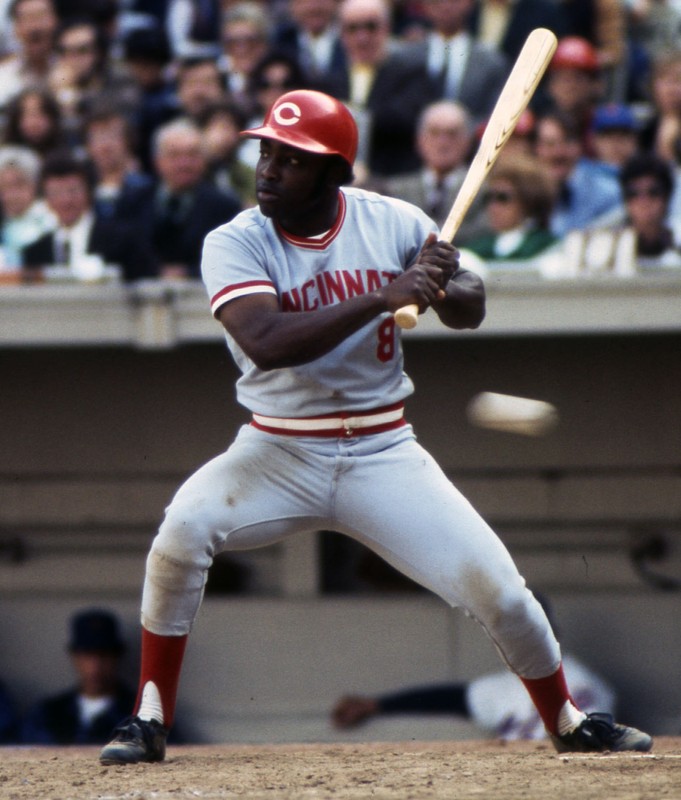Joe Morgan Statue
Introduction
Text-to-speech Audio
This statue commemorates Cincinnati Reds Hall-of-Fame second baseman Joe Morgan (1943-2020). A Texas native who grew up in Oakland, California, he is considered one of the greatest second basemen in baseball history. In eight seasons with the Reds (1972-79), Morgan won five consecutive Gold Glove Awards and two National League Most Valuable Player Awards. An integral component of Cincinnati’s “Big Red Machine” of the 1970s, he also made eight-straight All-Star Game appearances while playing for the organization. After the 1984 season, Morgan retired, finishing his major league career with 2,517 hits, 1,865 walks, 689 stolen bases, 268 home runs, and a .271 batting average. In 1990, the Baseball Writers’ Association of America elected him to the National Baseball Hall of Fame in his first year of eligibility. Following his retirement as a player, Morgan commenced a long and successful career as a sports broadcaster. From 1990 through 2010, he recreated games with Jon Miller for ESPN’s Sunday Night Baseball. After struggling with various health problems for a handful of years, he died at his home in Danville, California on October 11, 2020 at the age of seventy-seven. On September 7, 2013, the Reds unveiled a statue of Morgan near the intersection of Joe Nuxhall and Johnny Bench Ways just outside of Great American Ball Park. Designed by Cincinnati-based artist and University of Cincinnati alumnus Tom Tsuchiya, the life-sized bronze sculpture depicts the speedster breaking out of his leadoff stance and beginning his sprint toward second base in an attempt to steal it.
Images
Joe Morgan Statue just outside Great American Ball Park

Morgan poses for a picture with his bronze likeness shortly after the unveiling on September 7, 2013

Joe Morgan (1943-2020)

Backstory and Context
Text-to-speech Audio
Joe Leonard Morgan was born the eldest of six children to Ollie and Leonard Morgan on September 19, 1943 in the town of Bonham, Texas, just south of the Oklahoma border. When he was five years old, his family moved to Oakland, California, where his father found a job at the Pacific Tire and Rubber Company. Growing up in Oakland, Morgan played informal games of baseball, basketball, and football in the city’s playgrounds and streets before becoming a standout player in his local Babe Ruth League. At Castlemont High School, he was a three-sport athlete and helped lead the baseball team to a league championship. Morgan, however, graduated high school in 1961 without any professional contract offers from major league teams or scholarship offers from four-year colleges. Most big league clubs and major college programs believed him, at five feet, seven inches tall and only 140 pounds, to be too small to play baseball professionally or at the Division-I collegiate level. Consequently, Morgan enrolled at Oakland City College, where he played second base on the school’s baseball team. After leading the team in hitting and bases stolen, he attracted the attention of major league scouts. In November 1962, Morgan signed with the Houston Colt .45s (now the Houston Astros) and subsequently began playing in the organization’s minor league system.
Only a few days after his twentieth birthday, Morgan made his major league debut for the Colt .45s on September 21, 1963. He finished the season with the big league squad, but returned to the minors for the start of the 1964 season. Later that year, Morgan received another call-up, but this time remained in the major leagues for the rest of his professional career. He ultimately spent nine seasons with Houston, during which time he earned two All-Star Game selections. In November 1971, Houston traded Morgan to the Cincinnati Reds. Over the subsequent eight seasons, he helped power Cincinnati’s “Big Red Machine” to four National League pennants and two World Series titles. In that time, Morgan won five consecutive Gold Glove Awards and two National League Most Valuable Player Awards. He also made eight-straight All-Star Game appearances. Following the 1979 season, Morgan returned to Houston for one season before playing two for the San Francisco Giants and then one for the Philadelphia Phillies. After the 1984 season, which he spent with the Oakland Athletics, he retired, finishing his major league career with 2,517 hits, 1,865 walks, 689 stolen bases, 268 home runs, and a .271 batting average. In 1990, the Baseball Writers’ Association of America elected him to the National Baseball Hall of Fame in his first year of eligibility.
Following his retirement as a player, Morgan commenced a long and successful career as a sports broadcaster. He called games on television for the Reds, Giants, and Athletics before working for ABC and NBC. From 1990 through 2010, Morgan recreated games with Jon Miller for ESPN’s Sunday Night Baseball. After struggling with various health problems for a handful of years, he died at his home in Danville, California on October 11, 2020 at the age of seventy-seven.
On September 7, 2013, the Reds unveiled a statue of Morgan near the intersection of Joe Nuxhall and Johnny Bench Ways just outside of Great American Ball Park. Designed by Cincinnati-based artist and University of Cincinnati alumnus Tom Tsuchiya, the life-sized bronze sculpture depicts the speedster breaking out of his leadoff stance and beginning his sprint toward second base in an attempt to steal it. In addition to Morgan’s bronze likeness, Tsuchiya also sculpted the statues of Johnny Bench, Pete Rose, and Tony Pérez, as well as those of Joe Nuxhall, Ernie Lombardi, Ted Klususki, and Frank Robinson, a group of pieces collectively known as Reds Legends of Crosley Field, all of which reside just outside Great American Ball Park.
Sources
"Baseball Hall of Famer Joe Morgan dies at 77." espn.com. 12 October 2020. Web. 2 July 2021 <https://www.espn.com/mlb/story/_/id/30100016/baseball-hall-famer-joe-morgan-dies-77>.
Erardi, John. "Reds unveil Joe Morgan's statue, great 8 reunite." USA Today. 7 September 2013. Web. 2 July 2021 <https://www.usatoday.com/story/sports/mlb/reds/2013/09/07/reds-unveil-joe-morgan-statue-great-8-reunite/2781449/>.
Faber, Charles F. "Joe Morgan." sabr.org. Society for American Baseball Research. Web. 2 July 2021 <https://sabr.org/bioproj/person/joe-morgan/>.
"Joe Morgan." baseballhall.org. National Baseball Hall of Fame. Web. 2 July 2021 <https://baseballhall.org/hall-of-famers/morgan-joe>.
"Joe Morgan." Encyclopædia Britannica. Web. 2 July 2021 <https://www.britannica.com/biography/Joe-Morgan>.
Warnemuende, Jeremy. "Reds unveil Morgan's statue before Saturday's game." mlb.com. 7 September 2013. Web. 2 July 2021 <https://www.mlb.com/reds/news/reds-unveil-hall-of-famer-joe-morgans-statue-before-saturdays-game/c-59857238>.
https://www.redreporter.com/2020/10/12/21512861/joe-morgan-death-big-red-machine
https://www.usatoday.com/story/sports/mlb/reds/2013/09/07/reds-unveil-joe-morgan-statue-great-8-reunite/2781449/
https://baseballhall.org/discover/inside-pitch/blockbuster-trade-sends-morgan-to-reds
